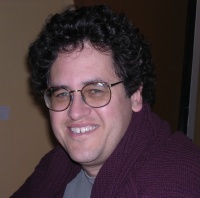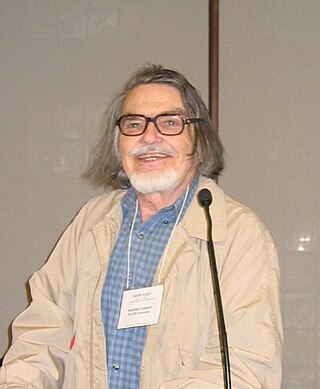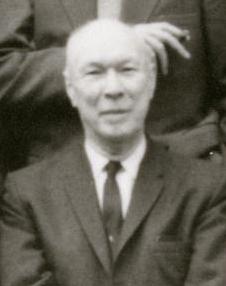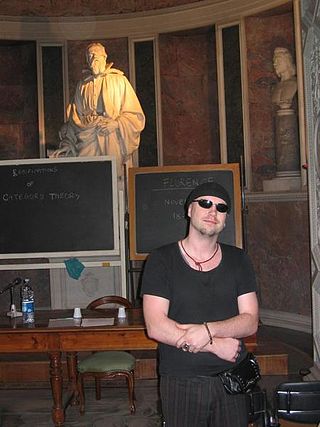Related Research Articles

John Carlos Baez is an American mathematical physicist and a professor of mathematics at the University of California, Riverside (UCR) in Riverside, California. He has worked on spin foams in loop quantum gravity, applications of higher categories to physics, and applied category theory. Additionally, Baez is known on the World Wide Web as the author of the crackpot index.
In the mathematical study of logic and the physical analysis of quantum foundations, quantum logic is a set of rules for manipulation of propositions inspired by the structure of quantum theory. The formal system takes as its starting point an observation of Garrett Birkhoff and John von Neumann, that the structure of experimental tests in classical mechanics forms a Boolean algebra, but the structure of experimental tests in quantum mechanics forms a much more complicated structure.

David Orlin Hestenes is a theoretical physicist and science educator. He is best known as chief architect of geometric algebra as a unified language for mathematics and physics, and as founder of Modelling Instruction, a research-based program to reform K–12 Science, Technology, Engineering, and Mathematics (STEM) education.
Michael Anthony Arbib is an American computational neuroscientist. He is an Adjunct Professor of Psychology at the University of California at San Diego and professor emeritus at the University of Southern California; before his 2016 retirement he was the Fletcher Jones Professor of computer science, as well as a professor of biological sciences, biomedical engineering, electrical engineering, neuroscience and psychology.

Joachim "Jim" Lambek was a Canadian mathematician. He was Peter Redpath Emeritus Professor of Pure Mathematics at McGill University, where he earned his PhD degree in 1950 with Hans Zassenhaus as advisor.

Irving Kaplansky was a mathematician, college professor, author, and amateur musician.

Gerard J. Murphy MRIA was a prolific Irish mathematician. His textbooks are internationally acclaimed, and translated into different languages. He died from cancer in October 2006, at the age of 57.

William Vermillion Houston was an American physicist who made contributions to spectroscopy, quantum mechanics, and solid-state physics as well as being a teacher and administrator. He became the second president of Rice University in 1946.
Edwin Bidwell Wilson was an American mathematician, statistician, physicist and general polymath. He was the sole protégé of Yale University physicist Josiah Willard Gibbs and was mentor to MIT economist Paul Samuelson. Wilson had a distinguished academic career at Yale and MIT, followed by a long and distinguished period of service as a civilian employee of the US Navy in the Office of Naval Research. In his latter role, he was awarded the Distinguished Civilian Service Award, the highest honorary award available to a civilian employee of the US Navy. Wilson made broad contributions to mathematics, statistics and aeronautics, and is well-known for producing a number of widely used textbooks. He is perhaps best known for his derivation of the eponymously named Wilson score interval, which is a confidence interval used widely in statistics.

Kalyanapuram Rangachari Parthasarathy was an Indian statistician who was professor emeritus at the Indian Statistical Institute and a pioneer of quantum stochastic calculus. Parthasarathy was the recipient the Shanti Swarup Bhatnagar Prize for Science and Technology in Mathematical Science in 1977 and the TWAS Prize in 1996.
Edmund Frederick Robertson is a professor emeritus of pure mathematics at the University of St Andrews.
In mathematics, particularly in abstract algebra, a semigroup with involution or a *-semigroup is a semigroup equipped with an involutive anti-automorphism, which—roughly speaking—brings it closer to a group because this involution, considered as unary operator, exhibits certain fundamental properties of the operation of taking the inverse in a group: uniqueness, double application "cancelling itself out", and the same interaction law with the binary operation as in the case of the group inverse. It is thus not a surprise that any group is a semigroup with involution. However, there are significant natural examples of semigroups with involution that are not groups.

Huzihiro Araki was a Japanese mathematical physicist and mathematician who worked on the foundations of quantum field theory, on quantum statistical mechanics, and on the theory of operator algebras.

James Dillon Stasheff is an American mathematician, a professor emeritus of mathematics at the University of North Carolina at Chapel Hill. He works in algebraic topology and algebra as well as their applications to physics.

Bob Coecke is a Belgian theoretical physicist and logician who was professor of Quantum foundations, Logics and Structures at Oxford University until 2020, when he became Chief Scientist of Cambridge Quantum Computing, and after the merger with Honeywell Quantum Systems, Chief Scientist of Quantinuum. In January 2023 he also became Distinguished Visiting Research Chair at the Perimeter Institute for Theoretical Physics. He pioneered categorical quantum mechanics, Quantum Picturalism, ZX-calculus, DisCoCat model for natural language, and quantum natural language processing (QNLP). He is a founder of the Quantum Physics and Logic community and conference series, and of the applied category theory community, conference series, and diamond-open-access journal Compositionality.
Effect algebras are partial algebras which abstract the (partial) algebraic properties of events that can be observed in quantum mechanics. Structures equivalent to effect algebras were introduced by three different research groups in theoretical physics or mathematics in the late 1980s and early 1990s. Since then, their mathematical properties and physical as well as computational significance have been studied by researchers in theoretical physics, mathematics and computer science.

Sergio Doplicher is an Italian mathematical physicist, who mainly dealt with the mathematical foundations of quantum field theory and quantum gravity.

Gudrun Kalmbach is a German mathematician and educator known for her contributions in the field of quantum logic and for the educational programmes she developed.
Anton Kazimirovich Sushkevich was a Russian mathematician and textbook author who expanded group theory to include semigroups and other magmas.
Patricia Frazer Lock is an American mathematician, mathematics educator, statistician, statistics educator, and textbook author whose research interests include social networks and quantum logic. She is the Cummings Professor of Mathematics at St. Lawrence University.
References
- 1 2 3 4 5 O'Connor, John J.; Robertson, Edmund F., "David James Foulis", MacTutor History of Mathematics Archive , University of St Andrews
- 1 2 3 4 Greechie, Richard J. (2012), "David James Foulis", Mathematica Slovaca, 62 (6): 1007–1018, doi: 10.2478/s12175-012-0061-6 , MR 3003774 .
- ↑ Adams, Donald H. (1973), "Equational classes of Foulis semigroups and orthomodular lattices", Proceedings of the University of Houston Lattice Theory Conference (Houston, Tex., 1973), Dept. Math., Univ. Houston, Houston, Tex., pp. 486–497, MR 0392721 .
- ↑ Jacobs, Bart (2010), "Orthomodular lattices, Foulis semigroups and dagger kernel categories", Logical Methods in Computer Science, 6 (2): 2:1, 26, arXiv: 0905.4090 , doi:10.2168/LMCS-6(2:1)2010, MR 2659590, S2CID 16137532 .
- 1 2 David J. Foulis at the Mathematics Genealogy Project
- ↑ "Obituary: David Foulis, Professor Emeritus of Mathematics and Statistics : UMass Amherst".
- ↑ Curriculum vitae: David James Foulis , retrieved 2015-08-29.